12:00 AM – Never Cry Wolf
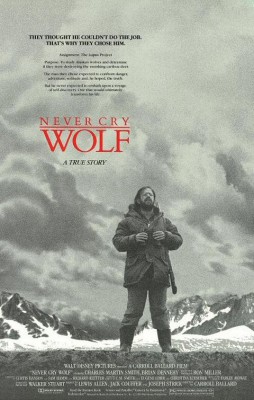 Leonard Maltin usually says goodnight during his introduction in the 10:00 hour, so from here on out he will likely be absent. Disney was struggling in the 1980’s to stay relevant with its film content. During this period, the company fought off several hostile takeover attempts and in order to diversify, Ron Miller led them in a direction away from family entertainment in an attempt to appeal to adults. Touchstone Pictures was established in February 1984, 1 month after Never Cry Wolf was released. Had the adult branding existed just one-month prior, this would have likely been the first Touchstone film. Instead, it is the first film under the newly labeled “Walt Disney Pictures” brand.
Leonard Maltin usually says goodnight during his introduction in the 10:00 hour, so from here on out he will likely be absent. Disney was struggling in the 1980’s to stay relevant with its film content. During this period, the company fought off several hostile takeover attempts and in order to diversify, Ron Miller led them in a direction away from family entertainment in an attempt to appeal to adults. Touchstone Pictures was established in February 1984, 1 month after Never Cry Wolf was released. Had the adult branding existed just one-month prior, this would have likely been the first Touchstone film. Instead, it is the first film under the newly labeled “Walt Disney Pictures” brand.
Never Cry Wolf tells the true story of Farley Mowat, a biologist sent to Alaska to study the habits of wild wolves to determine if they were responsible for the declining caribou population. In a landscape full of men trying to strike oil to get rich quick, Smith spends much of his time in solitude until a few members of the Inuit tribe take interest in his research efforts and help him to better understand the wild animals.
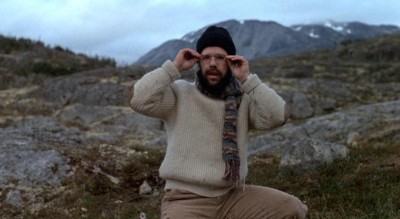 Featuring some beautiful cinematography, impressive staged animal action, and a great performance by Charles Martin Smith, Never Cry Wolf is a must-see. However, interested audience members should be prepared for a lot of unnecessary nudity, including brief full frontal during several shots. There are also some uncomfortable moments when Farley tries to match his diet with the wolves. Also be prepared for a typical 1980’s synthesized score, the only real giveaway that this film takes place in that decade.
Featuring some beautiful cinematography, impressive staged animal action, and a great performance by Charles Martin Smith, Never Cry Wolf is a must-see. However, interested audience members should be prepared for a lot of unnecessary nudity, including brief full frontal during several shots. There are also some uncomfortable moments when Farley tries to match his diet with the wolves. Also be prepared for a typical 1980’s synthesized score, the only real giveaway that this film takes place in that decade.
2:00 AM – White Wilderness
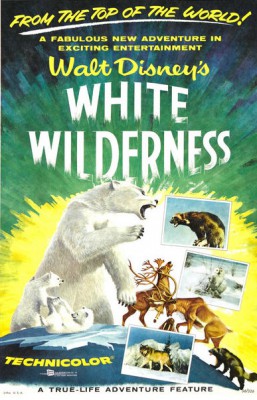 This Academy Award winning nature documentary from 1958 was one of the last films in the popular True-Life Adventures film series. The series began a decade prior in 1948 and when Disney’s distributor RKO refused to release the first short, Walt created the Buena Vista Distribution Co. RKO’s refusal to distribute Seal Island would cost them dearly when Disney decided not to renew the contract, now that Walt had his own distribution company.
This Academy Award winning nature documentary from 1958 was one of the last films in the popular True-Life Adventures film series. The series began a decade prior in 1948 and when Disney’s distributor RKO refused to release the first short, Walt created the Buena Vista Distribution Co. RKO’s refusal to distribute Seal Island would cost them dearly when Disney decided not to renew the contract, now that Walt had his own distribution company.
Like all True-Life Adventures, White Wilderness begins with an animated introduction that eventually leads into live action. The footage was shot over a three-year period in Canada. James Algar was an animation director with a passion for animals; He directed all of the True-Life Adventures, including this one. Narrator Winston Hibler was not an actor, but was a Disney writer who wound up producing and narrating all of the Disney nature films from this era.
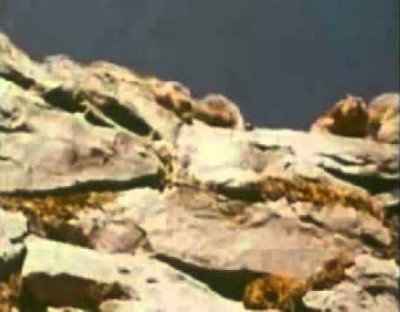 In this overview of arctic animals, the viewer is introduced to walruses, polar bears, beluga whales, wolves, caribou, oxen, wolverines and lemmings. For the most part, the animal action is authentic and Hibler’s narration tends to be comedic. However, the True-Life Adventures series sometimes staged, or “faked,” action and White Wilderness features the most infamous example of this. The lemmings depicted weren’t found in the wild, but were purchased from an Inuit tribe. The myth that they will follow their leader off a cliff was dramatically forced in this film, an act that has never been observed in the wild.
In this overview of arctic animals, the viewer is introduced to walruses, polar bears, beluga whales, wolves, caribou, oxen, wolverines and lemmings. For the most part, the animal action is authentic and Hibler’s narration tends to be comedic. However, the True-Life Adventures series sometimes staged, or “faked,” action and White Wilderness features the most infamous example of this. The lemmings depicted weren’t found in the wild, but were purchased from an Inuit tribe. The myth that they will follow their leader off a cliff was dramatically forced in this film, an act that has never been observed in the wild.
3:30 AM – Polar Trappers (Short)
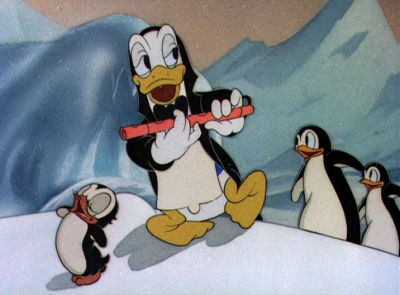 White Wilderness is only 72-minutes long. That means between the end of that film and 3:30, there will be 18-minutes of TCM commercials before this short, which will only fill half of its 15-minute timeslot. 1938’s Polar Trappers was the first time Donald Duck and Goofy had been paired together without Mickey Mouse.
White Wilderness is only 72-minutes long. That means between the end of that film and 3:30, there will be 18-minutes of TCM commercials before this short, which will only fill half of its 15-minute timeslot. 1938’s Polar Trappers was the first time Donald Duck and Goofy had been paired together without Mickey Mouse.
Both Donald and Goofy are trying to trap animals in the arctic. Goofy has set his sights on a walrus, while Donald attempts to lure a penguin for his supper (don’t think too much into that). Their unsuccessful antics result in hilarious consequences.
4:00 AM – The Island at the Top of the World
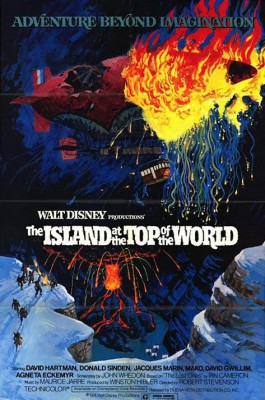 In the spirit of 20,000 Leagues Under the Sea, The Island at the Top of the World Is a Jules Verne-esque adventure film that spent six troubled years in production. A lot was riding on the film, which Disney expected to be a gigantic box office success. When it failed to make an impression, the studio returned to formulaic films and didn’t attempt anything so risky again until after Star Wars changed the landscape of filmmaking (how fitting that it airs the same night that a new Star Wars film debuts in theaters).
In the spirit of 20,000 Leagues Under the Sea, The Island at the Top of the World Is a Jules Verne-esque adventure film that spent six troubled years in production. A lot was riding on the film, which Disney expected to be a gigantic box office success. When it failed to make an impression, the studio returned to formulaic films and didn’t attempt anything so risky again until after Star Wars changed the landscape of filmmaking (how fitting that it airs the same night that a new Star Wars film debuts in theaters).
Four explorers unite on an adventure to save one of their sons, who disappeared on an archeological quest to find a lost viking island. Sailing aboard the airship Hyperion, the explorers discover that the island is still inhabited by viking descendants. However, their appearance gets them all in trouble as the vikings are willing to kill to prevent the outside world from discovering their secret location.
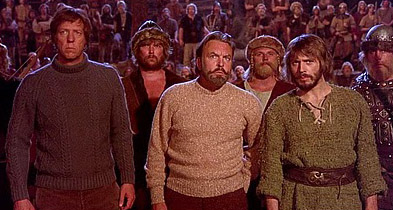 I’m curious if Island at the Top of the World would have been more successful today after recent hits like Thor and Frozen have brought Norwegian heritage into mainstream media. The film’s screenplay was written by John Whedon, grandfather of Joss Whedon who wrote and directed Marvel’s The Avengers and its sequel, both of which featured Thor. A statue of that same Norse god can be seen in this film. This was the final film produced by Winston Hibler (for other works, see White Wilderness).
I’m curious if Island at the Top of the World would have been more successful today after recent hits like Thor and Frozen have brought Norwegian heritage into mainstream media. The film’s screenplay was written by John Whedon, grandfather of Joss Whedon who wrote and directed Marvel’s The Avengers and its sequel, both of which featured Thor. A statue of that same Norse god can be seen in this film. This was the final film produced by Winston Hibler (for other works, see White Wilderness).
When The Island at the Top of the World was released in 1974, Disney already had a sequel in development and an entire land in the works for Disneyland called Discovery Bay, whose E-Ticket attraction would have been based on the film. However, the Discovery Bay plans were semi-realized twenty years later when Disneyland Paris opened. In place of Tomorrowland is Discoveryland, a Jules Verne inspired future which features the Hyperion docked in a hangar as the entrance to the Videopolis Theater.
And with that, another Treasures from the Disney Vault draws to a close. In all, I think this is the best job Leonard Matlin has done so far in terms of creating a cohesive evening of entertainment where each film thematically compliments the next. I hope you’ve enjoyed this look ahead (or behind, as the case may be) and I can’t wait until the next time Disney takes over TCM for an evening.
